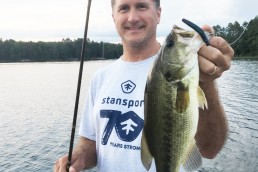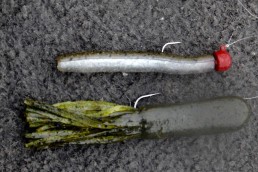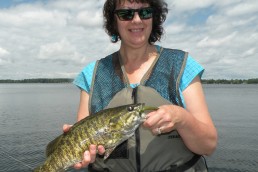The Ned-Style Finesse Rig
SHARE THIS POST
The ned rig is not only a good technique for bass, but also catches an amazingly wide variety of species. And furthermore, it is just as easy to learn or utilize as the wacky technique. This is the widely talked about Ned Rig finesse-style technique.
The Wacky Rig
A number of years ago, I wrote an article talking about one of the easiest and one of my favorite ways to catch bass. It consisted of a wacky-style rigged, 5-inch Berkley PowerBait worm on a wide-gap hook. The wacky style technique hooks the worm through the middle of the 5-inch worm, so it looks like a mustache hanging on the hook. It continues to be one of my favorite techniques, whether rigged under a slip float or just cast with a weighted wacky-style hook.
The reason I enjoy it so much, and have turned on so many people to the technique, is that you get to feel the “tug, tug, tug” of the fish and don’t have to worry about setting the hook immediately—or too soon and consequently, losing the fish. Especially with Berkley PowerBait, the attractant in the bait will cause the fish to hold onto the bait longer and even try to swim away with it. Feeling the bites, and the fish, makes it extremely fun, especially for newcomers to the fishing industry.
Providing novice anglers with the opportunity to really sense the bite and learn how to set the hook and catch fish is one of the hardest things to teach. The wacky-rig technique is very easy to learn. It’s kind of a “no-brainer” for catching fish, and you really don’t have to put any special action to the bait. The Wacky worm just free-falls or moves with the current and catches fish! Anyone can do it.
The Ned Rig
Recently, there has been another technique that is just as simple and has blown-up throughout the industry. And, it is not only a good technique for bass, but also catches an amazingly wide variety of species. And furthermore, it is just as easy to learn or utilize as the wacky technique. This is the widely talked about Ned Rig finesse-style technique.
Once again, I cannot believe how easy this technique is to learn, teach and catch fish with. As a matter of fact, in my opinion, there really is no finesse “technique” or learning curve at all. Very similar to the wacky rig system, all you do is cast it out, let it sink, and slowly lift your rod tip from a 3 o’clock horizontal position to a 12 or 1 o’clock position. From there, just reel in the slack line as you bring the rod tip back down parallel to the water. That’s it. And often times all there is to do is set the hook, because the fish will usually take the bait as it is falling in the water column.
The Ned Rig technique is like putting a piece of candy in front of a school kid. And, just like the wacky rig system, you get to feel the “tug, tug, tug” of the fish and have time before you need to set the hook. It’s another great technique for beginner and novice anglers, and realistically anyone who wants to catch fish.
Are you enjoying this post?
You can be among the first to get the latest info on where to go, what to use and how to use it!
A Ned Rig finesse style bait consists of a 3” plastic worm (or roughly half of a 5-inch Power Worm), threaded on a Strike King Tour Grade Ned Rig Head, Eagle Claw Pro-V Finesse Jig Head or similar flat-headed jig or mushroom style jig head. The benefit of the flat head of the jig is that it stands upright on the bottom of the lake, allowing the fish to pick up the worm, plastic (or rig) very easily.
Another nice thing about this system is that you can fish it with light gear. The lighter the gear, the more fun. My favorite combo to throw the Ned Rig on is a 7’ 2” medium-light Fenwick walleye rod. The light-action rod allows me to throw the lightweight bait a long way, and the high-modulus graphite allows me to detect the smallest of taps or bites from the fish.
Fishing the Ned
I have also been amazed at the variety of species that this technique can catch. In a span of about two days, I have had smallmouth and largemouth take the bait, as well as crappies, perch, rock bass (although rock bass seem to take anything anyway), walleyes and even pike.
As I mentioned, this technique is a no-brainer for teaching anyone the concept of “feel” or “bites” when fishing with any particular bait. Sometimes, bait pick-ups are hard to detect. And depending on the type of rod you have, water depth, line type and structure you are fishing, newcomers to the sport sometimes have a hard time discerning bites from snags, weeds or just bottom. If you have tried to teach anyone the concept of what “bites” feel like, you know that you can go through a lot of bait before someone gets the hang of it.
One last main ingredient to fishing the Ned Rig system and detecting subtle bites is to use the correct line. A superline like Berkley’s Fireline or X9 braid, or fluorocarbon line like Seaguar’s Finesse, or Strike King’s Tour Grade is a must. The low stretch aspect of these lines is paramount for detecting bait pick-ups.
My family loves fishing with this setup, and as I am primarily a boat-driver when taking the family fishing, it is very nice not having to re-bait a hook every time a fish steals a live-bait presentation.
Become a MidWest Outdoors Insider here!
MWO
SHARE THIS POST
Did you enjoy this post?
You can be among the first to get the latest info on where to go, what to use and how to use it!
Larry Ladowski
Larry Ladowski is a regular host on MidWest Outdoors TV and has been writing for MidWest Outdoors magazine for more than 25 years. Ladowski enjoys any time on the water and in the field, no matter where it happens to be and no matter what species he is fishing or hunting.



